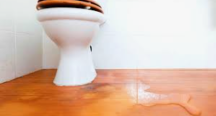If you’re dealing with a toilet leak in your HDB flat in Singapore, you’re not alone. Toilet leaks are a common issue in older buildings, and they can quickly escalate from a minor nuisance to a major headache if not addressed promptly. The problem is not just about the visible puddles of water on your bathroom floor; it’s about what’s happening beneath the surface. A leaking toilet can lead to significant water damage, mold growth, and even structural issues if the leak penetrates deep enough into the concrete slabs that make up the foundation of your HDB flat.
In this guide, we’ll explore why your toilet might be leaking, the temporary fixes you can try, and why a full-scale renovation might be the best long-term solution. We’ll also discuss the critical issue of worn waterproofing, which is often at the heart of persistent leaks in older HDB bathrooms. Finally, we’ll offer tips on finding the right contractor to ensure your bathroom is not only repaired but also upgraded to prevent future problems.
Understanding the Causes of Toilet Leaks in HDB Flats
Toilet leaks can originate from several sources, each requiring a different approach to fix. Understanding the root cause of the leak is the first step toward finding a solution that will last.
- Worn or Damaged Seals and Gaskets: The seals and gaskets in your toilet are responsible for keeping water where it belongs—inside the pipes and toilet bowl. Over time, these components can wear out, leading to leaks. Common signs of this problem include water pooling around the base of the toilet or leaking where the tank meets the bowl.
- Cracked Toilet Components: Ceramic toilets are durable but not immune to damage. A small crack in the toilet bowl or tank can lead to a slow but persistent leak. This issue can be particularly tricky to detect because the crack may be located in an area that isn’t immediately visible.
- Leaking Pipes: Pipes that supply water to your toilet or drain it away can develop leaks due to corrosion, wear and tear, or poor installation. These leaks are often hidden behind walls or under floors, making them harder to spot. You might notice damp patches on your bathroom walls, floor, or ceiling if the leak is severe.
- Faulty Water Closet (WC): The water closet, or toilet, itself can be the source of the leak. Issues like a faulty flush valve, fill valve, or other internal components can cause water to continuously flow into the bowl, leading to overflows or constant trickling. This not only wastes water but also puts extra strain on the seals and pipes.
- Worn Waterproofing: One of the most overlooked causes of bathroom leaks is worn waterproofing. In HDB flats, the waterproofing layer beneath the bathroom tiles is essential for preventing water from seeping into the concrete slab. Over time, this waterproofing can degrade, especially if it was not properly installed or has been compromised by previous repairs. When this happens, water can penetrate the floor, leading to leaks that affect not only your bathroom but also the flats below.
Temporary Solutions to Address Leaking Toilets
While it’s crucial to address the root cause of a toilet leak, temporary solutions can help mitigate the damage until you’re able to undertake more extensive repairs. These fixes won’t solve the problem long-term, but they can buy you some time and prevent further water damage.
- Tightening Bolts and Replacing Seals: If the leak is caused by a loose toilet or worn seals, you can try tightening the bolts that secure the toilet to the floor or replacing the gaskets. This is a relatively simple fix that can be done with basic tools. However, if the leak persists, it’s a sign that the problem might be more serious, and you should consider calling in a professional.
- Using Plumber’s Putty or Silicone Sealant: For small cracks or leaks around the base of the toilet, applying plumber’s putty or silicone sealant can create a temporary watertight barrier. These materials are easy to apply and can stop water from seeping out in the short term. However, they are not a permanent solution and should only be used as a stopgap measure until more substantial repairs can be made.
- Shutting Off the Water Supply: If the leak is severe and you’re unable to stop it with the above methods, the best course of action is to shut off the water supply to the toilet. This will prevent further water from entering the toilet and exacerbating the leak. While this isn’t a long-term fix, it will help prevent additional damage until you can schedule a professional repair.
- Temporary Pipe Repairs: If you suspect that a leaking pipe is the source of the problem, you can use pipe repair tape or a pipe clamp to temporarily seal the leak. These products are available at most hardware stores and can provide a quick fix while you arrange for a more permanent repair. Keep in mind that these solutions are only temporary, and the underlying issue will still need to be addressed by a qualified plumber.
- Applying Waterproofing Paint: If you notice that the waterproofing in your bathroom is failing, you can try applying waterproofing paint to the affected areas. or Using to Clear waterproofing coating for the existing floor tiles. This can help seal minor leaks and prevent water from penetrating the concrete slab. However, this is not a long-term solution, especially if the waterproofing layer beneath the tiles is compromised. A more comprehensive repair will be needed to fully address the issue.
Overhaul Solutions: Renovating Your HDB Bathroom for Long-Term Peace of Mind
While temporary solutions can provide some relief, they won’t address the underlying issues that cause toilet leaks. In many cases, a full-scale bathroom renovation is the best way to ensure that your bathroom is not only repaired but also upgraded to prevent future problems. This is particularly important in older HDB flats, where the original waterproofing and plumbing may be nearing the end of their lifespan.
- Replacing Damaged Components: During the renovation, all damaged components should be replaced. This includes the toilet itself, as well as any leaking pipes, worn seals, and faulty valves. Upgrading to modern, high-quality fixtures can help prevent future leaks and improve the overall functionality of your bathroom. Additionally, replacing old or damaged pipes with new ones, especially concealed piping, will reduce the risk of future leaks.
- Installing New Waterproofing: One of the most critical aspects of a bathroom renovation is installing a new waterproofing layer. This involves removing the old tiles and the existing waterproofing membrane, repairing any damage to the concrete slab, and then applying a new waterproofing membrane before re-tiling. Proper waterproofing is essential for preventing water from seeping into the floor and causing damage to the structure of your home or neighboring flats.
- Upgrading to Concealed Piping: Replace new concealed piping to protects the pipes from damage, reducing the likelihood of future leaks. This upgrade involves rerouting the plumbing so that the pipes are hidden within the walls or floors, creating a cleaner, more modern look. Don’t miss out those waste pipe and aircon piping underneath the cement.
- New Tiling and Finishes: After the new waterproofing layer is installed, it’s time to lay down new tiles. High-quality, non-porous tiles are recommended as they provide an additional layer of protection against water damage. The tiles should be installed with a slight slope toward the floor drain to ensure proper drainage and prevent water from pooling. In addition to tiling, you may also want to upgrade other bathroom finishes, such as the sink, shower, and lighting fixtures, to enhance the overall functionality and aesthetic of the space.
- Addressing Structural Issues: In some cases, long-term leaks can cause structural damage to your bathroom, such as cracks in the concrete slab or weakened walls. During the renovation, these issues should be addressed to ensure the integrity of your home’s structure. This might involve reinforcing the concrete, repairing cracks, or even replacing sections of the floor or walls if the damage is severe.
- Future-Proofing Your Bathroom: Finally, consider incorporating features that will help future-proof your bathroom against leaks and water damage. This might include installing a high-quality ventilation system to reduce humidity, adding a waterproof underlayment beneath the tiles, and using moisture-resistant materials for any cabinetry or storage. These upgrades can help prevent future leaks and ensure that your bathroom remains in top condition for years to come.
Finding the Right Contractor for Your HDB Bathroom Renovation
When it comes to something as crucial as a bathroom renovation, you want to make sure you’re working with a contractor who understands the unique challenges of HDB flats. This is where 9reno.com comes in. We specialize in HDB toilet leakage repair and bathroom renovations, offering a range of services to ensure your bathroom is not only repaired but also upgraded to prevent future issues.
Here’s why 9reno.com is the top choice for your HDB bathroom renovation:
- Expertise in HDB Regulations: We understand the specific regulations and requirements for renovations in HDB flats, ensuring that all work is fully compliant with HDB standards. This means you can have peace of mind knowing that your renovation will meet all necessary guidelines and won’t result in any regulatory issues down the road.
- Comprehensive Services: Whether you need a quick fix for a leaking toilet or a full-scale bathroom renovation, 9reno.com offers a comprehensive
Other related blog post for further reading :






Leave a Reply